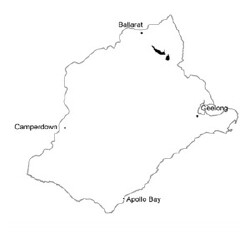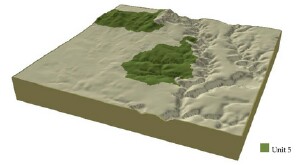Soil/Landform Unit 5
Landform Unit Description
Page top
 The forests west of Lal Lal are mainly Grassy and Heaty Dry Forests. Nearly 80% of this unit comprises significant remnant vegetation |
0.27% of CMA region |  |
|
 These low hills support grazing by sheep and beef cattle. |  |
 |  Plantation forestry is a land use of the Ordovician slopes and crests |
Component | 1 | 2 | 3 | 4 |
Proportion of soil-landform unit | 2% | 48% | 3% | 47% |
| CLIMATE Rainfall (mm) | Annual: 720 | |||
| Temperature (oC) | Minimum 7, Maximum 17 | |||
| Precipitation less than potential evapotranspiration | November-March | |||
| GEOLOGY Age and lithology | ||||
| Geomorphology | ||||
| LANDUSE | Uncleared: Nature conservation; water supply Cleared: Sheep and beef cattle grazing; softwood plantations; cropping (cereal); water supply | |||
| TOPOGRAPHY Landscape | Steep hills | |||
| Elevation range (m) | 309-538 | |||
| Local relief (m) | 65 | |||
| Drainage pattern | Dendritic | |||
| Drainage density (km/km2) | 3.5 | |||
| Landform | Hills | |||
| Landform element | Moist protected slopes | Dry exposed slopes | Drainage lines | Crests |
| Slope and range (%) | 15 (10-32) | 15 (10-32) | 3 (1-5) | 3 (1-6) |
| Slope shape | Straight | Straight | Concave | Convex |
| NATIVE VEGETATION Ecological Vegetation Class | Grassy Dry Forest (25.7%, Heathy Dry Forest (22.3%), Valley Grassy Forest (13.6%); Plains Grassy Woodland (5.9%); Herb-rich Foothill Forest (2.4%); other (0.9%) | |||
| Dominant species | E. obliqua, E. ovata, E. radiata, E. viminalis | E. obliqua, E. dives, E. radiata, E. viminalis | E. ovata, E. radiata, E. viminalis | E. obliqua, E. dives, E. radiata, E. viminalis |
| SOIL Parent material | In situ weathered sandstone and shale | In situ weathered sandstone and shale | Alluvium, clay, silt, sand, gravel | In situ weathered sandstone and shale |
| Description (Corangamite Soil Group) | Black gradational soil - variable (34) | |||
| Soil type sites | ||||
| Surface texture | Fine sandy loam | Fine sandy loam | Clay loam | Gravelly loam |
| Permeability | High | High | Moderate to low | High |
| Depth (m) | 1 | 2 | >1 | 0.5 |
| LAND CHARACTERISTICS, POTENTIAL AND LIMITATIONS | Steep slopes and hardsetting surfaces contribute to overland flow and sheet and rill erosion. Soil compaction also a limiation when soils are waterlogged. | Steep slopes and hardsetting surfaces contribute to overland flow and sheet and rill erosion. Soil compaction also a limitation when soils are waterlogged. | Moderate permeability soils with hardsetting surfaces. Subsoils are dispersible. Overland flow and subsurface flow compound waterlogging and gully erosion. Soil compaction also a limitation when soils are waterlogged. | Moderate slopes with hardsetting surfaces. Overland flow known to increase sheet and rill erosion. Soil compaction also a limitation when soils are waterlogged. |


